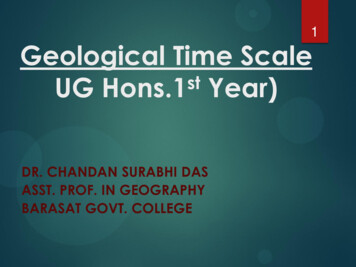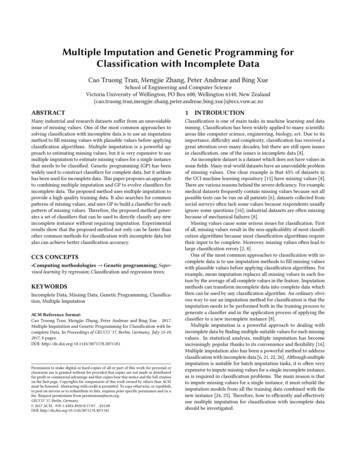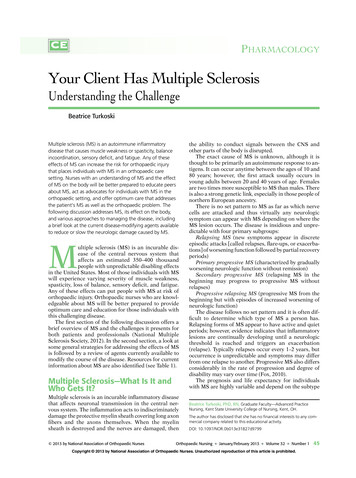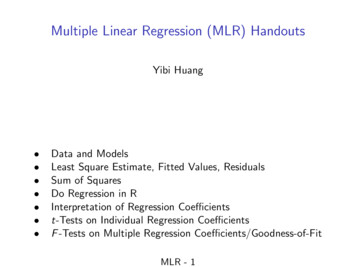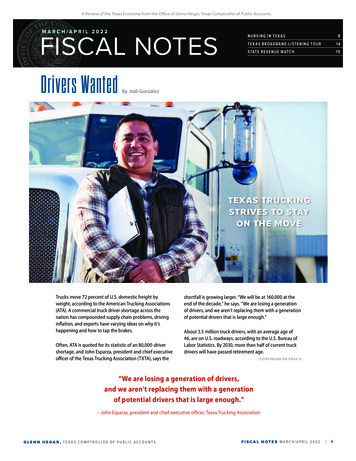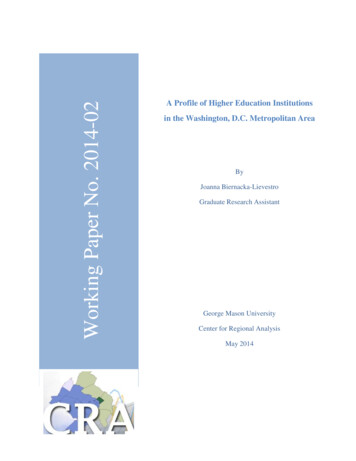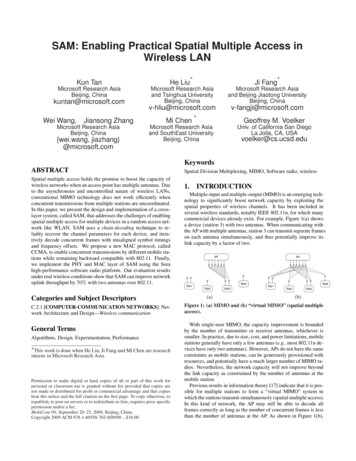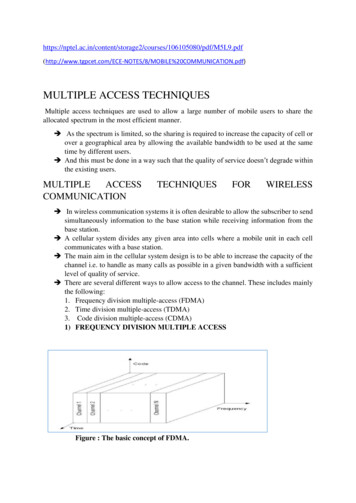
Transcription
8/MOBILE%20COMMUNICATION.pdf)MULTIPLE ACCESS TECHNIQUESMultiple access techniques are used to allow a large number of mobile users to share theallocated spectrum in the most efficient manner. As the spectrum is limited, so the sharing is required to increase the capacity of cell orover a geographical area by allowing the available bandwidth to be used at the sametime by different users. And this must be done in a way such that the quality of service doesn’t degrade withinthe existing LESS In wireless communication systems it is often desirable to allow the subscriber to sendsimultaneously information to the base station while receiving information from thebase station. A cellular system divides any given area into cells where a mobile unit in each cellcommunicates with a base station. The main aim in the cellular system design is to be able to increase the capacity of thechannel i.e. to handle as many calls as possible in a given bandwidth with a sufficientlevel of quality of service. There are several different ways to allow access to the channel. These includes mainlythe following:1. Frequency division multiple-access (FDMA)2. Time division multiple-access (TDMA)3. Code division multiple-access (CDMA)1) FREQUENCY DIVISION MULTIPLE ACCESSFigure : The basic concept of FDMA.
This was the initial multiple-access technique for cellular systems in which eachindividual user is assigned a pair of frequencies while making or receiving a call asshown in Figure. One frequency is used for downlink and one pair for uplink. This is called frequencydivision duplexing (FDD). That allocated frequency pair is not used in the same cell or adjacent cells during thecall so as to reduce the co channel interference. Even though the user may not be talking, the spectrum cannot be reassigned as long asa call is in place. Different users can use the same frequency in the same cell except that they musttransmit at different times. The features of FDMA are as follows: The FDMA channel carries only one phone circuit at a time. If an FDMA channel isnot in use, then it sits idle and it cannot be used by other users to increase share capacity. After the assignment of the voice channel the BS and the MS transmit simultaneouslyand continuously. The bandwidths of FDMA systems are generally narrow i.e. FDMA is usuallyimplemented in a narrow band system The symbol time is large compared to theaverage delay spread. The complexity of the FDMA mobile systems is lower than that of TDMA mobilesystems. FDMA requires tight filtering to minimize the adjacent channel interference. FDMA/FDD in AMPSThe first U.S. analog cellular system, AMPS (Advanced Mobile Phone System) is basedon FDMA/FDD.A single user occupies a single channel while the call is in progress, and the singlechannel is actually two simplex channels which are frequency duplexed with a 45 MHzsplit.When a call is completed or when a handoff occurs the channel is vacated so thatanother mobile subscriber may use it.Multiple or simultaneous users are accommodated in AMPS by giving each user aunique signal.Voice signals are sent on the forward channel from the base station to the mobile unit,and on the reverse channel from the mobile unit to the base station.In AMPS, analog narrowband frequency modulation (NBFM) is used to modulate thecarrier.FDMA/TDD in CT2 Using FDMA, CT2 system splits the available bandwidth into radio channels in theassigned frequency domain. In the initial call setup, the handset scans the available channels and locks on to anunoccupied channel for the duration of the call. Using TDD(Time Division Duplexing ), the call is split into time blocks that alternatebetween transmitting and receiving.
FDMA and Near-Far ProblemThe near-far problem is one of detecting or filtering out a weaker signal amongststronger signals.The near-far problem is particularly difficult in CDMA systems where transmittersshare transmission frequencies and transmission time.In contrast, FDMA and TDMA systems are less vulnerable. FDMA systems offerdifferent kinds of solutions to near-far challenge.Here, the worst case to consider is recovery of a weak signal in a frequency slot next tostrong signal.Since both signals are present simultaneously as a composite at the input of a gain stage,the gain is set according to the level of the stronger signal; the weak signal could be lostin the noise floor. Even if subsequent stages have a low enough noise floor to provide2) TIME DIVISION MULTIPLE ACCESS In digital systems, continuous transmission is not required because users do not use theallotted bandwidth all the time. In such cases, TDMA is a complimentary access technique to FDMA. Global Systemsfor Mobile communications (GSM) uses the TDMA technique. In TDMA, the entire bandwidth is available to the user but only for a finite period oftime. In most cases the available bandwidth is divided into fewer channels compared toFDMA. The users are allotted time slots during which they have the entire channel bandwidthat their disposal, as shown in FigureFigure : The basic concept of TDMA.
TDMA requires careful time synchronization since users share the bandwidth in thefrequency domain. The number of channels are less, inter channel interference is almostnegligible. TDMA uses different time slots for transmission and reception. This type of duplexingis referred to as Time division duplexing (TDD). The features of TDMA includes the following:a.TDMA shares a single carrier frequency with several users where each users makesuse of non overlapping time slots.b. The number of time slots per frame depends on several factors such as modulationtechnique, available bandwidth etc.c. Data transmission in TDMA is not continuous but occurs in bursts. This results inlow battery consumption since the subscriber transmitter can be turned OFF whennot in use. Because of a discontinuous trans- mission in TDMA the handoff processis much simpler for a subscriber unit, since it is able to listen to other base stationsduring idle time slots.d. TDMA uses different time slots for transmission and reception thus duplexers arenot required. TDMA has an advantage that is possible to allocate different numbers of time slots perframe to different users. Thus bandwidth can be supplied on demand to different users by concatenating orreassigning time slot based on priority.TDMA/FDD in GSM GSM is widely used in Europe and other parts of the world. GSM uses a variation ofTDMA along with FDD. GSM digitizes and compresses data, then sends it down a channel with two otherstreams of user data, each in its3)CODE DIVISION MULTIPLE ACCESS In CDMA, the same bandwidth is occupied by all the users, however they are allassigned separate codes, which differentiates them from each other shown in Figure CDMA utilize a spread spectrum technique in which a spreading signal (which isuncorrelated to the signal and has a large bandwidth) is used to spread the narrow bandmessage signal.Direct Sequence Spread Spectrum (DS-SS) This is the most commonly used technology for CDMA. In DS-SS, the message signal ismultiplied by a Pseudo Random Noise Code. Each user is given his own codeword which is orthogonal to the codes of otherusers and in order to detect the user, the receiver must know the codeword usedby the transmitter.
There are, however, two problems in such systems which are discussed in thesequel.Figure : The basic concept of CDMA.CDMA and Self-interference Problem In CDMA, self-interference arises from the presence of delayed replicas of signal dueto multipath. The delays cause the spreading sequences of the different users to lose theirorthogonality, as by design they are orthogonal only at zero phase offset. Hence in despreading a given user’s waveform, nonzero contributions to that user’ssignal arise from the transmissions of the other users in the network. This is distinct from both TDMA and FDMA, wherein for reasonable time or frequencyguardbands, respectively, orthogonality of the received signals can be preserved.CDMA and Near-Far Problem The near-far problem is a serious one in CDMA. This problem arises from the fact thatsignals closer to the receiver of interest are received with smaller attenuation than aresignals located further away. Therefore the strong signal from the nearby transmitter will mask the weak signal fromthe remote transmitter. In TDMA and FDMA, this is not a problem since mutual interference can be filtered.In CDMA, however, the near-far effect combined with imperfect orthogonality betweencodes (e.g. due to different time sifts), leads to substantial interference.
Accurate and fast power control appears essential to ensure reliable operation ofmultiuser DS-CDMA systems.Basic idea of these approaches can be explained in simple terms usingthe cocktail party theory. In a cocktail party people talk to each otherusing one of the following modes:FDMA: When all the people group in widely separated areas and talkwithin each group.TDMA: When all the people are in the middle of the room, but they taketurn in speaking.CDMA: When all the people are in the middle of the room, but differentpairs speak in different languages.
Multiple or simultaneous users are accommodated in AMPS by giving each user a unique signal. Voice signals are sent on the forward channel from the base station to the mobile unit, and on the reverse channel from the mobile unit to the base station. In AMPS, analog narrowband frequency modulation (NBFM) is used to modulate the .
